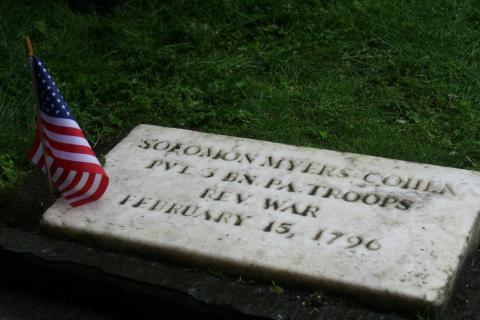Many people working in the financial district are familiar with New York’s oldest cemetery, the Trinity Churchyard located at the end of Wall Street and Broadway. Most people, however, are unaware that the second oldest extant burial ground in Manhattan is Shearith Israel’s Chatham Square cemetery. Only the most northern section of Trinity’s Churchyard predates it.
At the time of the American Revolution, the cemetery was in a strategic location on a hill overlooking the East River. Writing in March of 1776, Major General Charles Lee wrote to the Commander-in-Chief of the Continental Army, George Washington, the following:
The command of the Sound must be ours…The East River, I am persuaded, may be secured in such a manner that [British] ships will scarcely venture into it…A battery for this purpose is planned at the foot of the Jews’ burying ground. To protect this battery from the near approach of ships, guns in barbet placed on the heights of the Jews’ burying ground in correspondence with a battery on an opposite commanding knoll in Long Island, will certainly be sufficient.
When the British conquered New York, they too made use of this strategic position. It is also said that British soldiers removed several leaden epitaph plates from headstones in the cemetery in order to produce bullets.
A quaint and very special ceremony is held at the cemetery each year on the Sunday before Memorial Day. At this ceremony, we recite memorial prayers and plant flags at the graves of patriots of the American Revolution. Included among these patriots are our hazzan, Reverend Gershom Mendes Seixas, Benjamin Mendes Seixas, Simon Nathan, Jonas Phillips, and Hayman Levy among others. Descendants of these families are still active in our congregation today and frequently participate in these special services.
The small plot of land currently found at Chatham Square was once much larger. Erosion in the topology and the expansion of New York City caused several instances in which the congregation was forced reduce the size of the cemetery and, sadly, to disinter many of the remains buried there. Some of our earliest halakhic questions, directed to the Bet Din of the Spanish and Portuguese congregation of London, related to the permissibility and procedures of re-interment. Unfortunately, the issue recurred several times in our congregation’s history. This is probably the source for our custom today to declare burials in our cemetery as merely conditional. The size of the Chatham Square cemetery was severely reduced in the year 1855, when the expansion of the Bowery resulted in taking a large portion of the cemetery by eminent domain. Two hundred and fifty six graves had to be reinterred to accommodate the city’s expansion.
Well before this major change, a city ordinance in the year 1823 prohibited burial below Canal Street. As a result, the congregation moved to its second burial ground. Even so, a few burials still took place at Chatham Square after 1823.





